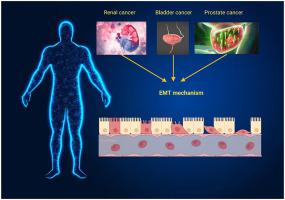Environmental Research ( IF 7.7 ) Pub Date : 2023-03-10 , DOI: 10.1016/j.envres.2023.115672 Peng He 1 , Qiang Dai 1 , Xiaojun Wu 1

|
A high number of cancer-related deaths (up to 90) are due to metastasis and simple definition of metastasis is new colony formation of tumor cells in a secondary site. In tumor cells, epithelial-mesenchymal transition (EMT) stimulates metastasis and invasion, and it is a common characteristic of malignant tumors. Prostate cancer, bladder cancer and renal cancer are three main types of urological tumors that their malignant and aggressive behaviors are due to abnormal proliferation and metastasis. EMT has been well-documented as a mechanism for promoting invasion of tumor cells and in the current review, a special attention is directed towards understanding role of EMT in malignancy, metastasis and therapy response of urological cancers. The invasion and metastatic characteristics of urological tumors enhance due to EMT induction and this is essential for ensuring survival and ability in developing new colonies in neighboring and distant tissues and organs. When EMT induction occurs, malignant behavior of tumor cells enhances and their tend in developing therapy resistance especially chemoresistance promotes that is one of the underlying reasons for therapy failure and patient death. The lncRNAs, microRNAs, eIF5A2, Notch-4 and hypoxia are among common modulators of EMT mechanism in urological tumors. Moreover, anti-tumor compounds such as metformin can be utilized in suppressing malignancy of urological tumors. Besides, genes and epigenetic factors modulating EMT mechanism can be therapeutically targeted for interfering malignancy of urological tumors. Nanomaterials are new emerging agents in urological cancer therapy that they can improve potential of current therapeutics by their targeted delivery to tumor site. The important hallmarks of urological cancers including growth, invasion and angiogenesis can be suppressed by cargo-loaded nanomaterials. Moreover, nanomaterials can improve chemotherapy potential in urological cancer elimination and by providing phototherapy, they mediate synergistic tumor suppression. The clinical application depends on development of biocompatible nanomaterials.
中文翻译:

泌尿系肿瘤治疗的新见解:从上皮-间质转化(EMT)到纳米生物材料的应用
大量与癌症相关的死亡(多达 90 例)是由于转移所致,而转移的简单定义是肿瘤细胞在次要部位形成新的集落。在肿瘤细胞中,上皮-间质转化(epithelial-mesenchymal transition,EMT)刺激转移和侵袭,是恶性肿瘤的共同特征。前列腺癌、膀胱癌和肾癌是泌尿系肿瘤的三种主要类型,其恶性和侵袭行为是由于异常增殖和转移所致。EMT 已被充分证明是促进肿瘤细胞侵袭的机制,在当前的综述中,特别关注了解 EMT 在泌尿系统癌症的恶性肿瘤、转移和治疗反应中的作用。由于 EMT 诱导,泌尿系统肿瘤的侵袭和转移特性增强,这对于确保存活和在邻近和远处组织和器官中发展新集落的能力至关重要。当EMT诱导发生时,肿瘤细胞的恶性行为增强,它们倾向于产生治疗耐药性,尤其是化疗耐药性,这是导致治疗失败和患者死亡的根本原因之一。lncRNA、microRNA、eIF5A2、Notch-4 和缺氧是泌尿系肿瘤中 EMT 机制的常见调节剂。此外,抗肿瘤化合物如二甲双胍可用于抑制泌尿系统肿瘤的恶性肿瘤。此外,调节EMT机制的基因和表观遗传因子可以在治疗上靶向干预泌尿系肿瘤的恶性肿瘤。纳米材料 当EMT诱导发生时,肿瘤细胞的恶性行为增强,它们倾向于产生治疗耐药性,尤其是化疗耐药性,这是导致治疗失败和患者死亡的根本原因之一。lncRNA、microRNA、eIF5A2、Notch-4 和缺氧是泌尿系肿瘤中 EMT 机制的常见调节剂。此外,抗肿瘤化合物如二甲双胍可用于抑制泌尿系统肿瘤的恶性肿瘤。此外,调节EMT机制的基因和表观遗传因子可以在治疗上靶向干预泌尿系统肿瘤的恶性肿瘤。纳米材料 当EMT诱导发生时,肿瘤细胞的恶性行为增强,它们倾向于产生治疗耐药性,尤其是化疗耐药性,这是导致治疗失败和患者死亡的根本原因之一。lncRNA、microRNA、eIF5A2、Notch-4 和缺氧是泌尿系肿瘤中 EMT 机制的常见调节剂。此外,抗肿瘤化合物如二甲双胍可用于抑制泌尿系统肿瘤的恶性肿瘤。此外,调节EMT机制的基因和表观遗传因子可以在治疗上靶向干预泌尿系肿瘤的恶性肿瘤。纳米材料 eIF5A2、Notch-4 和缺氧是泌尿系统肿瘤中 EMT 机制的常见调节剂。此外,抗肿瘤化合物如二甲双胍可用于抑制泌尿系统肿瘤的恶性肿瘤。此外,调节EMT机制的基因和表观遗传因子可以在治疗上靶向干预泌尿系统肿瘤的恶性肿瘤。纳米材料 eIF5A2、Notch-4 和缺氧是泌尿系统肿瘤中 EMT 机制的常见调节剂。此外,抗肿瘤化合物如二甲双胍可用于抑制泌尿系统肿瘤的恶性肿瘤。此外,调节EMT机制的基因和表观遗传因子可以在治疗上靶向干预泌尿系统肿瘤的恶性肿瘤。纳米材料是泌尿系统癌症治疗中的新兴药物,它们可以通过靶向递送至肿瘤部位来提高当前疗法的潜力。载货纳米材料可以抑制泌尿系统癌症的重要特征,包括生长、侵袭和血管生成。此外,纳米材料可以提高化疗在泌尿系统癌症消除方面的潜力,并且通过提供光疗,它们可以协同抑制肿瘤。临床应用取决于生物相容性纳米材料的开发。











































 京公网安备 11010802027423号
京公网安备 11010802027423号